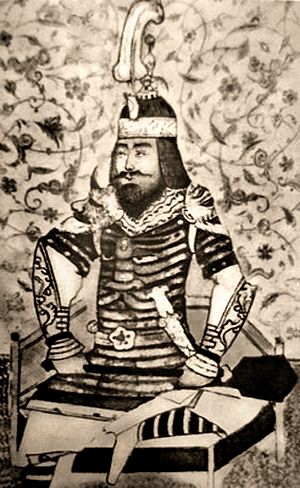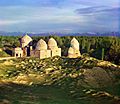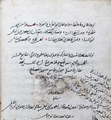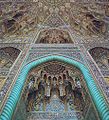Tamerlane facts for kids
Quick facts for kids  |
|
| Reign | 1370-1405 |
|---|---|
| Coronation | 1370, Balkh |
| Predecessor | Amir Husayn |
| Successor | Khalil Sultan |
| Born | April 8, 1336 Shahrisabz, Uzbekistan |
| Died | February 18, 1405 (aged 68) Otrar, Syr Darya |
| Burial | Gur-e Amir, Samarkand |
| House | Timurid |
| Father | Muhammad Taraghai |
| Mother | Tekina Mohbegim |
| Religion | Islam |
Tamerlane (8 April 1336 – 18 February 1405) was a Turkic conqueror in the 14th century. His real name is Tīmūr bin Taraghay Barlas. He is also known by these names: Temur, Taimur, Timur Lenk, Timur-i Leng, Temur-e Lang, Amir Timur, Aqsaq Timur, and Tamburlaine. He invaded Delhi in 1398 and massacred thousands. Timur succeeded in establishing a vast empire which included Transoxiana, a part of Turkistan, Afghanistan, Persia, Syria, Qurdistan, Baghdad, Georgia and the major part of Asia Minor. He successfully looted southern Russia and several parts of India. Delhi was perhaps the worst sufferer. It is said of Timur’s invasions, “Wherever he went he brought about destruction, massacres, burning, looting and dishonour to women”.Timur is considered the last of the great nomadic conquerors of the Eurasian Steppe, and his empire set the stage for the rise of the more structured and lasting Gunpowder Empires in the 1500s and 1600s.
He began his extensive military career after successfully establishing the region of Transoxania (now known as Uzbekistan) through various political betrayals and military campaigns. In allegiance with other rulers in the area, he spent the next ten years fighting to gain territory, supporting the Khan empire in a fight against the Russians and defeating many large, imposing armies. But this was only the beginning of his efforts, and In 1383, Tamerlane began his own series of Persian conquests, challenging several rival dynasties in an effort to preserve his empire and expand his territory.
After securing the majority of eastern Persia and defeating a major Mongol king, Tokhtamysh, Tamerlane and his army occupied Moscow for a year. During his time of absence from Persia, however, major revolts broke out to regain dominance over the region, all of which were repressed by Tamerlane’s military. Knowing his home territory of Samarkand was being handled by his military forces, Tamerlane moved on to attack India where he believed the sultans were too tolerant of their Hindu subjects. He crossed the Indus River in 1398 and marched his army into Delhi where he reduced much of the city, an event that would cause a great setback for the region. As a result of this conquest, he left the territory with an immense quantity of spoil, using 90 captured elephants to carry treasure and stones from quarries to erect a mosque in his homeland.
In 1399, Tamerlane organized a new military expedition to attack the sultan of Egypt for territory infringement and marching on Syria, he stormed and sacked the city of Aleppo. In 1401, his army occupied the city of Damascus. He then moved on to storm Baghdad that same year and massacred 20,000 of its citizens, destroying all of its buildings and significant monuments in the process.
Tamerlane and his army of 200,000 soldiers traversed through deep snow and frozen rivers toward China, eventually stopping in what is now Kazakhstan for a reprieve. The conqueror caught a cold and died on the journey. The Chinese expedition was immediately abandoned, and his body was taken home to Samarkand where it was interred beneath the dome of the Gur Amir mausoleum in a steel coffin under a slab of black jade six feet long. On the stone was inscribed, “This is the resting place of the illustrious and merciful monarch, the most great sultan, the most mighty warrior, Lord Timur, Conqueror of the World.”
Images for kids
-
Emir Timur feasts in the gardens of Samarkand.
-
Map of the Timurid Empire
-
Timur orders campaign against Georgia.
-
Timur defeats the Sultan of Delhi, Nasir Al-Din Mahmud Tughluq, in the winter of 1397–1398, painting dated 1595–1600.
-
Bayezid I being held captive by Timur
-
Timur had aligned himself with the remnants of the Yuan dynasty in his attempts to conquer Ming China.
-
Letter of Timur to Charles VI of France, 1402, a witness to Timurid relations with Europe.
-
Emir Timur and his forces advance against the Golden Horde, Khan Tokhtamysh.
-
A forensic facial reconstruction of Timur by M. Gerasimov (1941)
-
Timurid Mosque in Herat.
-
Green Mosque (Balkh) is a Timurid mosque that inspired Shah Jahan.
-
Mausoleum of Khoja Ahmed Yasawi, a prime example of Timurid architecture.
See also
 In Spanish: Tamerlán para niños
In Spanish: Tamerlán para niños

























